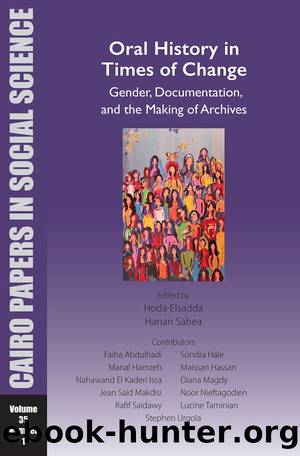Oral History in Times of Change: Gender, Documentation, and the Making of Archives by Hoda Elsadda Hanan Sabea

Author:Hoda Elsadda, Hanan Sabea [Hoda Elsadda, Hanan Sabea]
Language: eng
Format: epub
ISBN: 9781617979217
Barnesnoble:
Publisher: American University in Cairo Press, The
Published: 2018-09-11T00:00:00+00:00
I was met by Umm Ibrahim, an elderly woman in her sixties . . . . She said, âWeâre from Saasaa, do you know it? . . . She continued, telling me about it and about the two massacres that occurred there. . . .
Umm Ibrahim put her hand to her breast and showed me the key suspended on a cord around her neck. She said, âThe key to our house.â . . .
Later on I would learn that most of the women of the camp carried the keys to their houses, just as my mother did. (Ashour 2014:74)
Palestine in the Voice of Women
When we strive to rebuild the past, it is founded on the present, âthe memories of others and the great frameworks of the societyâs memoryâ (Halbwachs 2012:35). Moreover, the âsuccession of memories, even the most subjective, is always explained by the changes in our relationships in the different social milieus, i.e., the transformations of these milieus, whether for each individual or as a wholeâ (Halbwachs 1997:95). Conversely, the fact that this history depends on the written archiveâarticles, reports, letters, maps, and the likeâdoes not deny the dependence of al-Tanturiya on oral transmission. The stories, songs, musical compositions, folk proverbs, and other elements of the oral heritage that make up the public oral history are all focused on the memories of the narrative characters.
The memories of these characters are deconstructed into geographically based collective memories of Palestinian society. While Ruqayyaâs memory depends on Tantoura, the building of the Palestinian collective memory is built up from the memories of other villages such as Ain Ghazal, Zummarin, Qisarya, Saffurya, Balad al-Sheikh, al-Zeeb, Samakh, Saasaa, Lid, Ramla, and many others, as recounted by the characters belonging to these villages. Radwa Ashour has to a great extent reconstructed the âsocial morphologyâ of Palestine in the 1930s (population, forms of assembly and housing, the forms of Palestinian villages and towns, the communication between them including the means of transportation), the Nakba, and the dispersion of Palestinians into the refugee camps of Lebanon and other neighboring countries.
The traditions of marriage celebrations, memorized by the thirteen-year-old Ruqayya in Tantoura, are revived in 1957 at Ain al-Helwa camp in Sidon (Lebanon) during the marriage of Ezz (Aminâs brother and Ruqayyaâs cousin) to a girl from Saffurya. They are also recalled in the marriage of Ruqayyaâs son Hassan in Piraeus (Greece) to Fatma, who comes from the Palestinian city of Lid. Women chanted the traditional wedding songs:
Download
This site does not store any files on its server. We only index and link to content provided by other sites. Please contact the content providers to delete copyright contents if any and email us, we'll remove relevant links or contents immediately.
| Africa | Americas |
| Arctic & Antarctica | Asia |
| Australia & Oceania | Europe |
| Middle East | Russia |
| United States | World |
| Ancient Civilizations | Military |
| Historical Study & Educational Resources |
Never by Ken Follett(2907)
Machine Learning at Scale with H2O by Gregory Keys | David Whiting(2317)
The Man Who Died Twice by Richard Osman(2307)
Fairy Tale by Stephen King(2090)
Will by Will Smith(2061)
Rationality by Steven Pinker(1773)
The Dark Hours by Michael Connelly(1579)
The Dawn of Everything: A New History of Humanity by David Graeber & David Wengrow(1577)
Principles for Dealing With the Changing World Order: Why Nations Succeed and Fail by Ray Dalio(1385)
Friends, Lovers, and the Big Terrible Thing by Matthew Perry(1343)
A Short History of War by Jeremy Black(1304)
HBR's 10 Must Reads 2022 by Harvard Business Review(1260)
Go Tell the Bees That I Am Gone by Diana Gabaldon(1244)
Can't Hurt Me: Master Your Mind and Defy the Odds - Clean Edition by David Goggins(1240)
515945210 by Unknown(1216)
Fear No Evil by James Patterson(1116)
443319537 by Unknown(1079)
Works by Richard Wright(1022)
Going There by Katie Couric(997)
